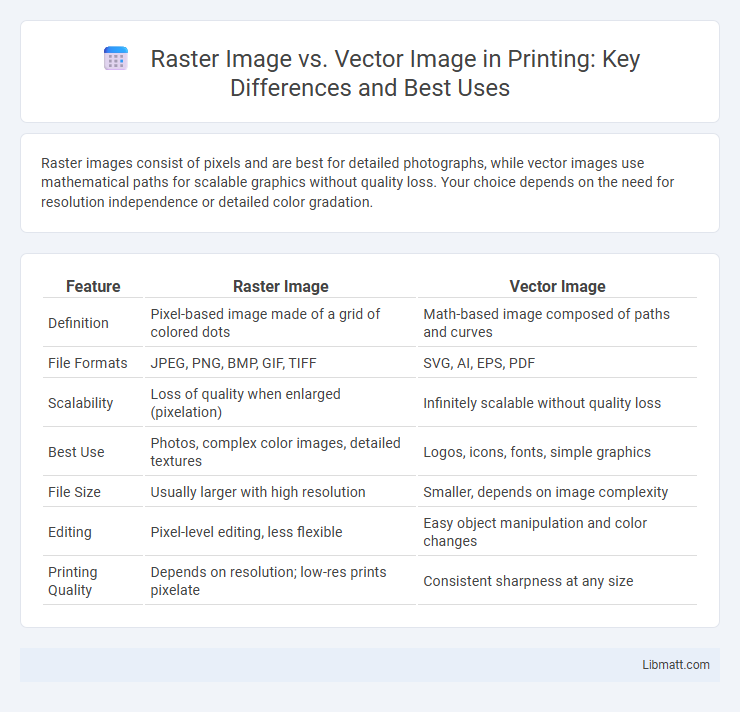Raster images consist of pixels and are best for detailed photographs, while vector images use mathematical paths for scalable graphics without quality loss. Your choice depends on the need for resolution independence or detailed color gradation.
Table of Comparison
| Feature | Raster Image | Vector Image |
|---|---|---|
| Definition | Pixel-based image made of a grid of colored dots | Math-based image composed of paths and curves |
| File Formats | JPEG, PNG, BMP, GIF, TIFF | SVG, AI, EPS, PDF |
| Scalability | Loss of quality when enlarged (pixelation) | Infinitely scalable without quality loss |
| Best Use | Photos, complex color images, detailed textures | Logos, icons, fonts, simple graphics |
| File Size | Usually larger with high resolution | Smaller, depends on image complexity |
| Editing | Pixel-level editing, less flexible | Easy object manipulation and color changes |
| Printing Quality | Depends on resolution; low-res prints pixelate | Consistent sharpness at any size |
Introduction to Raster and Vector Images
Raster images consist of pixels arranged in a grid, making them ideal for detailed photographs but prone to losing quality when scaled. Vector images are composed of mathematical paths, allowing them to be resized infinitely without any loss of clarity, perfect for logos and illustrations. Understanding the differences helps you choose the right format for your project's needs, balancing detail and scalability.
Key Definitions: Raster vs Vector
Raster images are composed of a fixed grid of pixels, each with defined color values, making them ideal for detailed photographs but lose quality when scaled. Vector images use mathematical equations to create shapes and lines, allowing them to be resized infinitely without a loss in clarity, perfect for logos and graphic designs. The fundamental difference lies in raster's pixel-based structure versus vector's scalable paths, affecting their usage in digital and print media.
How Raster Images Work
Raster images consist of a grid of individual pixels, each assigned a specific color value, creating detailed and complex visuals suitable for photographs. The resolution of a raster image directly affects its quality, as increasing the size can cause pixelation and loss of clarity. Understanding how your raster image works helps optimize it for digital displays, where pixel density and color depth influence the overall appearance and performance.
How Vector Images Work
Vector images use mathematical equations and geometric primitives such as points, lines, and shapes to represent visual elements, allowing infinite scalability without loss of quality. Unlike raster images that rely on pixels, vector graphics store image data as paths defined by coordinates, making them ideal for logos, icons, and illustrations requiring precise and clear rendering at any size. This method enables smaller file sizes and efficient editing, as individual components can be manipulated independently.
File Formats: Raster vs Vector
Raster image file formats include JPEG, PNG, GIF, and BMP, characterized by pixel-based data that defines color and detail. Vector image file formats like SVG, AI, and EPS use mathematical equations to represent shapes and paths, allowing infinite scalability without loss of quality. Understanding the difference in file formats helps you choose the right type for your design needs, ensuring clarity and flexibility in output.
Image Quality and Scalability Differences
Raster images consist of pixels, which can cause quality loss and pixelation when scaled beyond their original resolution, limiting their scalability for large prints or screen displays. Vector images use mathematical equations to create shapes, ensuring sharp and clear quality at any size without distortion, making them ideal for logos and illustrations. Your choice between raster and vector formats will significantly impact the clarity and adaptability of your graphics across different media.
Common Uses and Applications
Raster images, composed of pixels, are ideal for detailed photos, digital paintings, and complex color gradients, making them perfect for web graphics, digital photography, and social media content. Vector images use mathematical paths to create scalable graphics without loss of quality, commonly applied in logo design, typography, and print materials such as brochures and billboards. Understanding these differences helps you choose the right format for your project, ensuring optimal quality and flexibility.
Pros and Cons of Raster Images
Raster images offer rich detail and color depth, making them ideal for complex photographs and digital artwork, but their quality degrades when scaled up, leading to pixelation. They support millions of colors and subtle shading, which benefits photo editing and web graphics. Your choice of raster images may require careful resolution management to maintain clarity across different display sizes.
Pros and Cons of Vector Images
Vector images offer scalable graphics that maintain clarity at any size, making them ideal for logos and illustrations requiring precision. Their smaller file sizes enable faster loading and efficient storage, but complex designs can be challenging to render and edit. Your choice depends on whether you prioritize scalability and editability over photographic detail.
Choosing the Right Format for Your Project
Raster images consist of pixels, making them ideal for detailed photographs but less scalable without quality loss, while vector images use mathematical paths, ensuring sharpness when resized, which suits logos or icons. When choosing the right format for your project, consider whether you need high-resolution color depth or scalable graphics that maintain clarity across different sizes. Understanding the distinctions helps you select the optimal format, ensuring your visuals appear crisp and professional in all applications.
Raster image vs vector image Infographic

 libmatt.com
libmatt.com